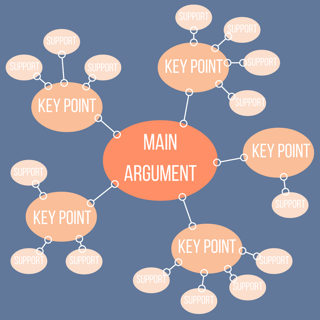
As a legal professional, you're in the business of constantly composing new writing samples - be they pleadings, speeches, client letters, or blog posts. All this writing isn't easy, especially when your goal is to finish quickly... and cover all your bases... and sway your audience... and stay within your page limit. Luckily, there are ways to improve your writing while simultaneously making the process less exhausting; the secret is planning ahead. Through strategic planning, you'll be able to convey your message in a more efficient way - which means fewer words, less time, and greater impact.
Prepare
First, identify your thesis or core argument. Decide who your audience is, and define a successful outcome as it pertains to your specific application - whether you're teaching, convincing, storytelling, or summarizing.
Next, perform a thorough brain dump and write down everything you want to include in your composition, including facts, opinions, issues, ideas, assumptions, rules, conclusions and assertions. This preliminary step will give you an overview of all the elements you're working with, so you can formulate a more comprehensive and substantiated argument. Scribbles and messy notes are fine for now - as long they're legible enough to re-read later.
Organize
Once you have everything written down, use outlines to weave these strings of information together into one cohesive fabric. There are a multitude of ways to do this, but I find that bubble trees, flow charts, and traditional outlines are the easiest to create and utilize.

Bubble trees are my favorite type of outline; I use them to create my daily to-do lists, map out my annual goals, and decide what to pack before I travel. Always start by writing your purpose, thesis, or core argument in the center circle, and drawing first-level branches for all the bigger themes or concepts.
For example, if my core argument is "MerusCase is the best legal technology on market", I might designate my first-level branches accordingly: extensive features and capabilities, affordable pricing and ease/accessibility, loyal and satisfied clients, great culture and devoted support staff, numerous product integrations and automations, high-grade security and protection protocols, and limitations of competitors.
Break down each of your first- and second-level branches until you have: a) utilized all of the relevant content from your brain dump; and b) identified specific documents, quotes, statistics, and other resources that will help you prove your point.

Flow charts are extremely versatile and can be used in a variety of projects. When it comes to planning your writing, flow charts are particularly great for creating seamless chronology and visualizing the flow of logic that your audience will follow. Because of their flexibility, flow charts are also useful for mapping out arguments that have uncertain turning points. For example, if you don't know what approach your opposing counsel will take in court, flow charts will help your prepare for all possibilities. For a full tutorial on creating and using flowcharts, check out this guide from Creately.
.png?width=320&name=Outline%20(1).png)
Since you are well-versed in the IRAC method, you're likely to benefit from the structural similarity of traditional (skeletal) outlines. These outlines are easy to construct, formal enough to present to your colleagues, and can be used to organize any type of writing. Because of their presence in academic writing circles, most traditional outlines follow a standardized format - but as this guide from the University of Richmond shows, they can be as broad or as detailed as you'd like.
Whichever outline format you choose, focus on ideas, concepts, and logical thinking, rather than on word choice or grammar. Go with the flow; if you're stuck on phrasing, just leave yourself a ______ or [a suggestion, synonym, or paraphrase] - then move on.
Construct
Finally, begin your composition and use your outline as a roadmap; you'll be surprised how much easier it is to write when you've already thought through the brunt of your argument.

Leave a Reply